Finding it difficult to choose a climbing plant for a shaded location? Don’t worry! Our list of Foliage and Flowering Vines for Shade is going to come in handy!
Vines that love to thrive in the shade can brighten up the gloomy-looking north or east-facing parts of your garden. Here are some of the best Flowering Vines for Shade that you can easily grow!
Have a look at the best purple vines you can grow as houseplants here
Best Flowering Vines for Shade
The plants mentioned on this list will be more than happy to dwell in the shade as long as they get some amount of direct or indirect light. We have also included plants that can grow well in partial shade, like roses, clematis, and honeysuckle.
1. Roses

Botanical Name: Rosa ‘Wedding Day’
USDA Zones: 5-11
Floribundas and shrub roses can bloom in part sun. This means that you can grow them at a spot that gets at least 4 hours of direct sun and shade for the rest of the day, which is comparatively less than other types of roses that need full sun.
‘Scarborough Fair,’ ‘Kew Gardens,’ ‘Lady of Shalott,’ and ‘William and Catherine’ are the best ones you can grow for shade. Make sure to use well-draining soil.
Have a look at the best shade loving roses here
2. Sweet Autumn Clematis
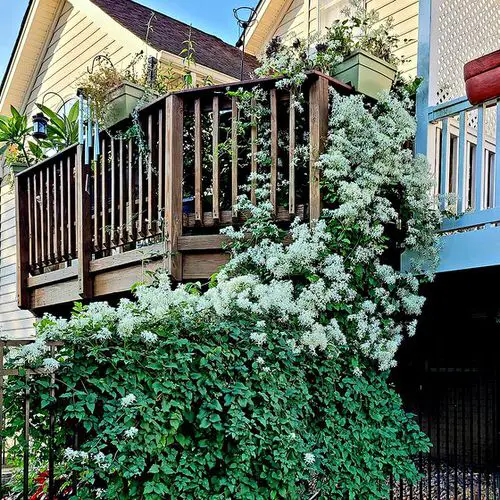
Botanical Name: Clematis paniculata
USDA Zones: 4-11
This climber is famous for producing fragrant white flowers in the partially-shaded areas of the garden with ease.
3. Sausage Vine
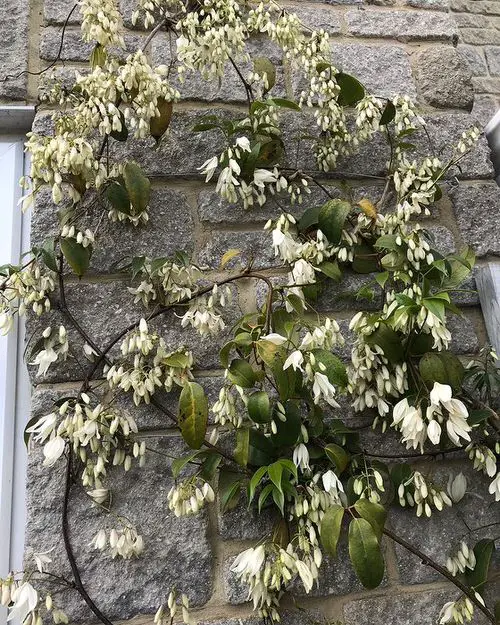
Botanical Name: Holboellia coriacea
USDA Zones: 8-11
This frost-hardy climber grows up to 12-16 feet in length. It prefers the sunlit area but also does well in the shade. The plant produces scented pale pink flowers in spring or summer over palmate leaves.
4. Climbing Hydrangea

Botanical Name: Hydrangea anomala ssp. petiolaris
USDA Zones: 4-8
Climbing hydrangeas are an excellent choice for low-light shady areas. They offer clusters of aromatic white blooms from late spring through summer.
Learn to grow hydrangea from cuttings here
5. Wisteria
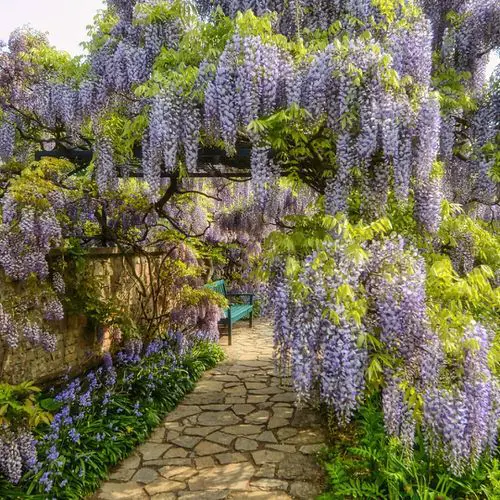
Botanical Name: Wisteria sinensis
USDA Zones: 5-9
Chinese wisteria offers long-hanging bunches of white-purple blooms. The plant is usually full of foliage in the shade, but give it a little sun if you want profound flowers.
6. Dutch Honeysuckle
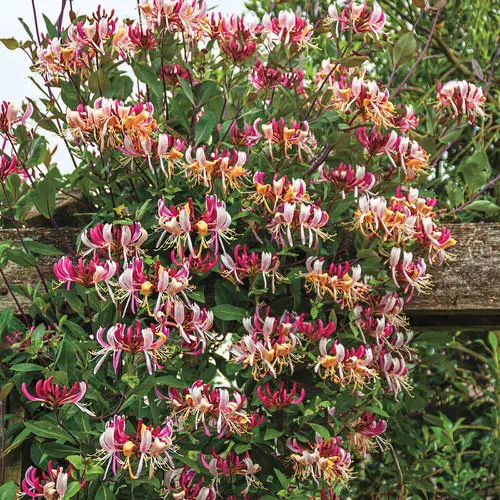
Botanical Name: Lonicera periclymenum ‘Serotina’
USDA Zones: 5-9
This slow-growing and deciduous vine grows 10-20 feet tall and produces tubular, crimson blooms with creamy-yellow throats and dark green oval leaves.
7. Confederate Jasmine

Botanical Name: Trachelospermum jasminoides
USDA Zones: 7-10
‘Asiatic jasmine’ and ‘Madison jasmine’ are ideal choices for shady areas. They offer shiny dark green leaves, elliptical-shaped, and sweet-scented white blooms.
Check out the best indoor Jasmine varieties here
8. Bleeding Heart

Botanical Name: Clerodendrum thomsoniae
USDA Zone: 9 and above
Clerodendrum bleeding heart is a sensible and non-aggressive plant. This flowering vine performs well in dappled or partial shade though it also survives in full sun.
9. Sweet Pea

Botanical Name: Lathyrus latifolius
USDA Zones: 3-8
This easy-to-grow annual vine can thrive in partial shade. It offers sweet-spicy fragrant flowers in shades of pink, purple, white, and red hues from spring or early summer.
10. Butterfly Vine
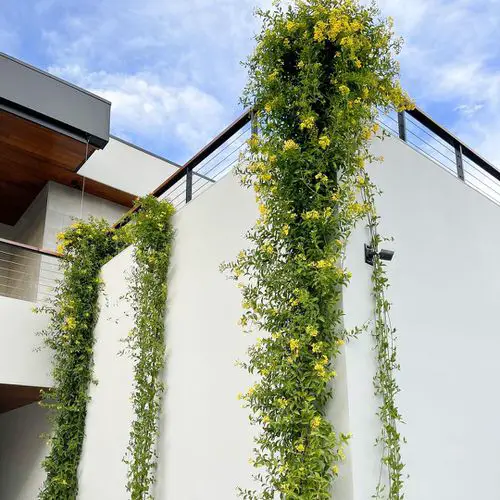
Botanical Name: Mascagnia macroptera
USDA Zones: 8-10
This fast-growing climber thrives in partial shade and showcases yellow blooms during spring and summer that ultimately turn brown.
11. American Potato Bean

Botanical Name: Apios americana
USDA Zone: 3-8
This easy-to-grow plant offers blooms that look like red Wisteria. Avoid planting this invasive climber in the garden bed with perennials.
12. Passion Flower

Botanical Name: Passiflora caerulea
USDA Zone: 7-11
This easy-to-grow vine can reach up to 20-30 feet (6-9 mt) tall. You can grow cultivars like ‘Chinensis’ with pale blue flowers and ‘Constance Elliott,’ ideal flowering vines for shade.
13. Chocolate Vine
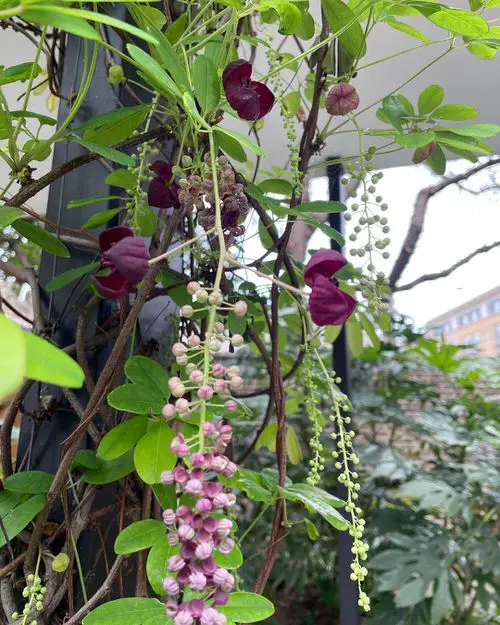
Botanical Name: Akebia quinata
USDA Zone: 4-9
The chocolate vine forms hanging purple flowers and glossy, oval-shaped, dark green leaves in spring. It also produces eggplant-like edible fruits in late summer.
14. Butterfly Pea

Botanical Name: Clitoria ternatea
USDA Zone: 9-11
This vine does wonderfully well in shaded areas of the garden. However, keep them safe from waterlogged soil.
Check out some of the best blue flowers to grow in containers here!
15. Evergreen Clematis

Botanical Name: Clematis vitalba
USDA Zone: 7-11
This famous ornamental vine is known for its vigorous growing nature. Wherever you’ll plant it, the Clematis will soon paint the area with its sweet-smelling white flowers!
16. Blue Trumpet Vine

Botanical Name: Thunbergia Grandiflora
USDA Zone: 9-11
If you live in a warm climate, this is one of the best vines to grow. Its cup-shaped flowers come in pale yellow and cream blue shades that look like morning glory.
17. Japanese Hydrangea Vine
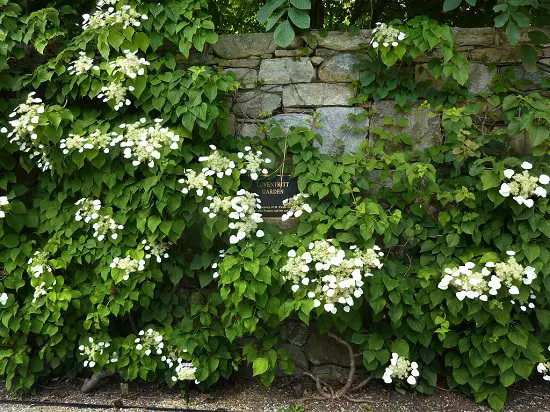
Botanical Name: Schizophragma hydrangeoides
USDA Zone: 5-8
Excellent for fences and walls, Japanese Hydrangea Vine can add an instant appeal with its dark green foliage and honey-scented, creamy white lace-cap flowers.
18. Nepalese Paper Plant

Botanical Name: Daphne bholua
USDA Zone: 7-10
With oblanceolate leaves and clusters of intensely fragrant flowers, the Nepalese paper plant should be your pick for flowering vines for shade. Originating from the Himalayas, it grows best in moderately cool and subtropical climates.
19. Crimson Glory Vine
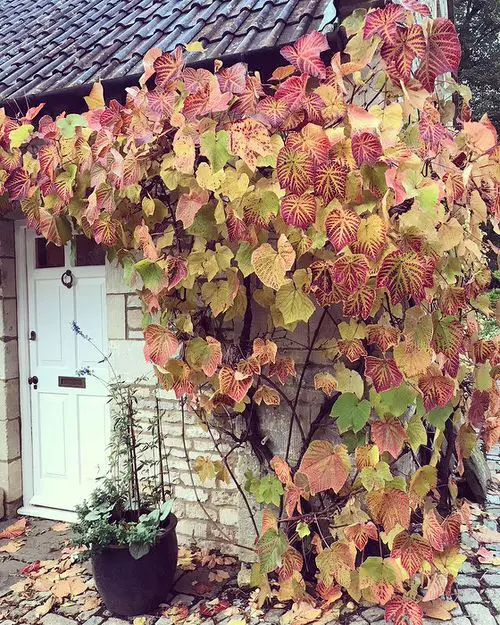
Botanical Name: Vitis coignetiae
USDA Zones: 6-9
This vine is a great option to hide a wall or other messy sight in the garden. It grows fast and produces heart-shaped leaves that turn scarlet, orange, and crimson-purple in fall.
Check out the best climbing houseplants here
20. Kadsura Vine

Botanical Name: Kadsura japonica
USDA Zone: 7-10
Kadsura is a semi-evergreen vine that thrives well in the shade and forms yellow or white flowers in the spring. Mostly, it is grown for red berries and variegated leaves.
21. Emerald Gaiety Euonymus
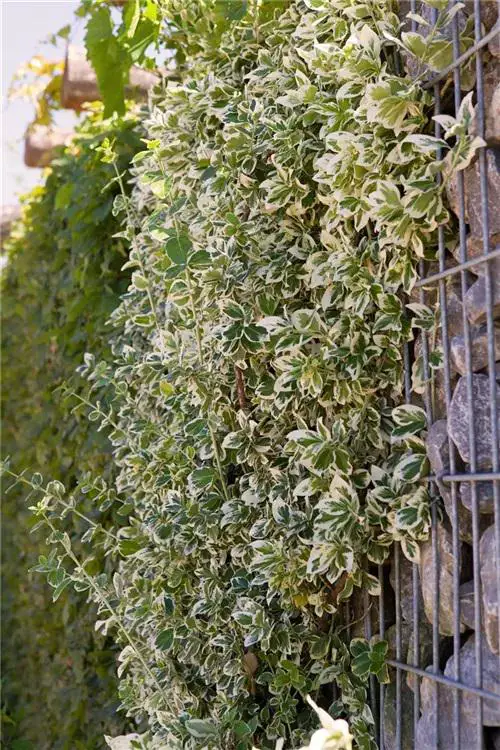
Botanical Name: Euonymus fortunei
USDA Zones: 5-8
This plant can either be a vine or a shrub and offers green and white variegated leaves. You can grow it in partial shade in well-draining soil.
22. Variegated Kiwi Vine
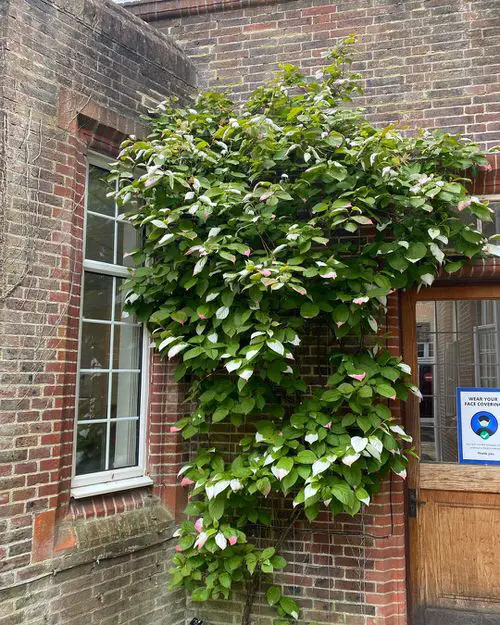
Botanical Name: Actinidia Kolomikta
USDA Zones: 3-9
This climber shows off small white blooms during spring. Under a light shade, it forms foliage in white, pink, and green hues.
23. Variegated Magnolia Vine
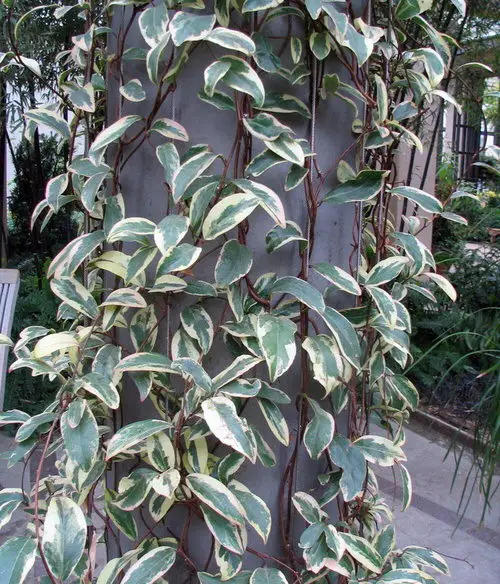
Botanical Name: Kadsura Japonica
USDA Zones: 4-7
This evergreen climbing shrub is an ideal choice for shade. It produces yellow or white blooms in spring and grows 10-15 feet tall. The plant also grows red berries.
24. English Ivy

Botanical Name: Hedera helix
USDA Zones: 4-11
Ivy can tolerate the darkest shade and can thrive all year round. It looks stunning with its deep green or variegated leaves. However, it is important to note that this vine can be invasive in favorable climates!
Check out the best Ivy varieties here
25. Pothos
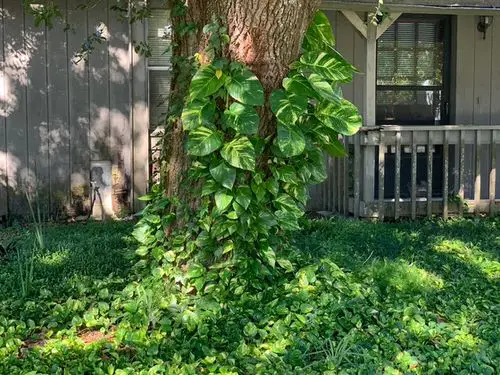
Botanical Name: Epipremnum aureum
USDA Zones: 10-12
Golden pothos is a great option for full to partially shaded outdoors. Famous for its heart-shaped lush green leaves, this plant can climb up to 30-40 feet tall outside.
Find out the large foliage pothos varieties here
26. Virginia Creeper

Botanical Name: Parthenocissus
USDA Zones: 3-9
This deciduous climber affixes itself to fences and walls with sucker discs and sets on masses of growth each season. For best growth and color, make sure it gets a little sun.
Check out the best indoor vines and climbers to grow at home here



Need more info about Butterfly Pea & Chocolate plant & Blue Trumpet vine .
How tall & width , soil conditions. Moisture requirements? I live in Oklahoma zone 7 and it gets hot hot in August & early September some days 100+ but certainly high 90’s with humidity off & on. Looking for several areas one protected from West sun with a large tree and another trellis 4-5 hours of West sun (12:00 to 4 or5). I do not like invasive, self sowing plants.
Google is your friend: chocolate vine is invasive! Most of these actually are. DON’T plant them!
Are these vines “invasive” if planted in large galvanized wash basins instead of in the ground?
Bad advice on anything invasive – just because you can trim and “control” it in your yard does not mean it is safe for the local environment! Squirrels, birds, and other natural spreading will cause it to spread beyond your yard to areas where it cannot be controlled – and they will choke out other naturally growing plants! There’s a reason it’s on a do not plant list!
How on Earth can you claim that something named “Lonicera japonica” is native to America?!?!? Its English name is Japanese honeysuckle! I’m guessing maybe you got confused with Coral Honeysuckle, which is indeed a native plant? And yes, the Japanese one is highly invasive.
is the passion flower invasive….and if so can it be controlled very easily. Also can it take any sun at all???
not typically invasive unless you are in the tropics and yes they prefer full sun
I planted a passion vine last year (2021) and while it did grow rapidly and my arbor was beautiful, it is self-seeding. I would call it invasive because even though I pulled it out of the ground shoots are still growing. Plus, it latches on to everything within reach.
Passiaflora incarnata is native to the southeastern United States. Other passim flora are, unfortunately, invasive species. Incarnata grows best in full sun, but can be grown in partial or light shade. It also has edible fruit. The rest of the vines presented above are, unfortunately, invasive species.
The photo of the Clerodendrum Thompsonii is wrong! The photo is of a Dicentra! The problem with common names, like bleeding heart, is that they do not really identify a plant; they just tell you what folks call a given plant in that part of the world!
Ugh! Honeysuckle is a terrible invasive! And why not recommend our Native American wisteria instead of the Asian variety. Times are changing. We should be eradicating invasives and planting natives!
Thank you, thank you, thank you!!
I live 17 stories up with a concrete balcony. That virginia creeper would be perfect. It can cover those ugly concrete walls. Id feel like i was sitting in a jungle rather than a concrete box. The Wisteria would look lovely draped around the ledge. I do have trellis stands around the opening.